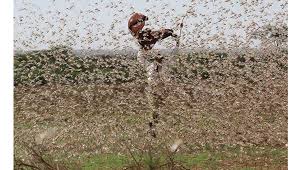Locust control operations have been carried in 315,636 hectares area in states of Rajasthan, Madhya Pradesh, Punjab, Gujarat, Uttar Pradesh. Maharashtra, Chhattisgarh, Haryana and Bihar by Locust Circle Offices (LCOs) in 33 days.
Till 14th July 2020, control operations have been done in 147,321 hectares area in states of Rajasthan, Madhya Pradesh, Punjab, Gujarat, Uttar Pradesh, Maharashtra, Chhattisgarh, Haryana and Bihar by state governments.
Presently 79 control teams with spray equipment mounted vehicles and more than 200 central government personnel, 50 Technical officers and 22 drivers on contractual basis, are engaged in locust control operations. Also, 15 new Ulvamast sprayers have reached India from the UK.
Further, 5 companies with 15 drones are deployed at Barmer, Jaisalmer, Bikaner, Nagaur and Phalodi in Rajasthan for effective control of locusts on tall trees and in inaccessible areas through spraying of pesticides. A Bell helicopter has been deployed in Rajasthan for use in the Scheduled Desert Area as per the need. Indian Air Force is also conducting trials in anti-locust operation by using a Mi-17 helicopter.
No significant crop losses have been reported in the states of Gujarat, Uttar Pradesh, Madhya Pradesh, Maharashtra, Chhattisgarh, Bihar and Haryana. However, some minor crop losses have been reported in some districts of Rajasthan.
Food and Agriculture Organization’s Locust Status Update indicates that more swarms are likely to form in northern Somalia in coming weeks and that locust migration from northeast Somalia across the Indian Ocean to the summer breeding areas along both sides of the Indo-Pakistan border could be imminent. Many of the spring-bred swarms migrated to the Indo-Pak border before the monsoon rains, some continued east to northern states of India and a few groups reached Nepal.
The forecast is that these swarms will return to Rajasthan with the start of the monsoon in the coming days to join other swarms still arriving from Iran and Pakistan, which is expected to be supplemented by swarms from the Horn of Africa in about mid-July.
